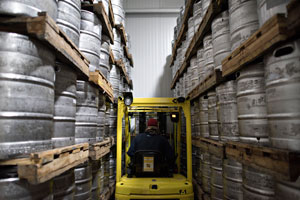Wholesale Prices Rise for Third Time in Four Months

Wholesale prices in the U.S. rose for the third time in four months, boosted by increasing fuel costs that are pushing inflation higher throughout the economy.
The producer price index gained 0.3% in December, matching the median projection of economists surveyed by Bloomberg News, following a 0.4% advance the prior month, a Labor Department report showed Jan. 13 in Washington. The measure was up 1.6% from a year earlier, the most since September 2014.
The uptick is a sign that broader measures of inflation will continue to approach the goal of Federal Reserve policymakers, as costs pick up worldwide. Steady consumer demand and more stable commodity costs are expected to help keep prices in the production pipeline on an upward track, though the dollar’s strength could constrain increases.
Separately on Jan. 13, the Commerce Department reported that retail sales strengthened in December on rising demand for motor vehicles, though the picture was mixed at other stores.
Projections for producer prices ranged from an advance of 0.1% to 0.5%, according to the Bloomberg survey.
Prices had risen 1.3% in November from a year earlier.
Energy prices rose 2.6% from the prior month, as gasoline jumped 7.8%, accounting for almost half of the December rise in goods prices. Food costs showed a 0.7% increase, the most since January 2016.
Wholesale prices excluding food and energy rose 0.2% from the previous month following a 0.4% rise. Those costs were up 1.6% from December 2015.
Services inflation moderated, with prices rising 0.1% in December following a 0.5% increase.
Excluding food, energy and trade services, producer costs rose 0.1% after climbing 0.2% the previous month.
Some economists prefer this reading because it strips out the most volatile components of PPI.
Compared with a year earlier, this core measure increased 1.7% after a 1.8% gain.
One takeaway from the report was stable health-care prices, from a gauge used to calculate the Commerce Department’s consumer spending inflation index, the Fed’s preferred price measure. Those costs were unchanged in December from the prior month, before adjusting for seasonal variations. They rose 1.6% from a year earlier.
The producer price gauge is one of three monthly inflation reports released by the Labor Department, the other two being import costs and consumer prices.
The Fed targets 2% annual gains in the Commerce Department’s personal consumption expenditures price index. That gauge rose 1.4% in November from a year earlier.

